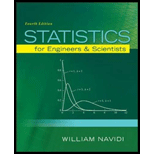
Concept explainers
A system consists of two components connected in series. The system will fail when either of the two components fails. Let T be the time at which the system fails. Let X1, and X2 be the lifetimes of the two components. Assume that X1 and X2 are independent and that each has the Weibull distribution with α = 2 and β = 0.2.
a. Find P(X1 > 5).
b. Find P(X1 > 5 and X2 > 5).
c. Explain why the
d. Find P(T ≤ 5).
e. Let t be any positive number. Find P(T ≤ t), which is the cumulative distribution
f. Does T have a Weibull distribution? If so, what are its parameters?
a.
Find the value of
Answer to Problem 13E
The value of
Explanation of Solution
Given info:
The total number of components is 2. The random variable T is defined as the time at which the system fails. The random variables
Assume that the lifetimes are independent. The random variables
Calculation:
The random variables
Weibull distribution:
The probability density function of the Weibull distribution with parameters
The cumulative distribution function of the Weibull distribution with parameters
Substitute
Thus, the value of
b.
Find the value of
Answer to Problem 13E
The value of
Explanation of Solution
Calculation:
Here, the random variables
Then the joint probability density function is the product of the marginal, each of which is Weibull with parameters
From part (a),
Then,
Thus, the value of
c.
Explain the reason behind the event
Explanation of Solution
The random variable T is defined as the time at which the system fails.
The random variables
Thus, the lifetime of the system will be greater than 5 hours if and only if the lifetimes of both components greater than 5 hours.
Hence, the event
d.
Find the value of
Answer to Problem 13E
The value of
Explanation of Solution
Calculation:
The random variable T is defined as the time at which the system fails.
From part (b), the value of
From, part(c), it is clear that the event
Then,
Substitute
Thus, the value of
e.
Find the cumulative distribution function of T.
Answer to Problem 13E
The cumulative distribution function of T is,
Explanation of Solution
Calculation:
Here the random variables
Then the joint probability density function is the product of the marginal, each of which is Weibull with parameters
Substitute
Then,
From, part(c), it is clear that the event
Then,
Thus, the value of
f.
Check whether T has a Weibull distribution or not. Find the parameters if so.
Answer to Problem 13E
The random variable T follows Weibull distribution with parameter
Explanation of Solution
The cumulative distribution function of the Weibull distribution with parameters
From (e), the cumulative distribution function of T is,
Thus, the random variable T follows Weibull distribution with parameter
Want to see more full solutions like this?
Chapter 4 Solutions
Statistics for Engineers and Scientists
- A company found that the daily sales revenue of its flagship product follows a normal distribution with a mean of $4500 and a standard deviation of $450. The company defines a "high-sales day" that is, any day with sales exceeding $4800. please provide a step by step on how to get the answers in excel Q: What percentage of days can the company expect to have "high-sales days" or sales greater than $4800? Q: What is the sales revenue threshold for the bottom 10% of days? (please note that 10% refers to the probability/area under bell curve towards the lower tail of bell curve) Provide answers in the yellow cellsarrow_forwardFind the critical value for a left-tailed test using the F distribution with a 0.025, degrees of freedom in the numerator=12, and degrees of freedom in the denominator = 50. A portion of the table of critical values of the F-distribution is provided. Click the icon to view the partial table of critical values of the F-distribution. What is the critical value? (Round to two decimal places as needed.)arrow_forwardA retail store manager claims that the average daily sales of the store are $1,500. You aim to test whether the actual average daily sales differ significantly from this claimed value. You can provide your answer by inserting a text box and the answer must include: Null hypothesis, Alternative hypothesis, Show answer (output table/summary table), and Conclusion based on the P value. Showing the calculation is a must. If calculation is missing,so please provide a step by step on the answers Numerical answers in the yellow cellsarrow_forward
 Linear Algebra: A Modern IntroductionAlgebraISBN:9781285463247Author:David PoolePublisher:Cengage Learning
Linear Algebra: A Modern IntroductionAlgebraISBN:9781285463247Author:David PoolePublisher:Cengage Learning
